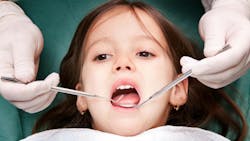Orofacial myology: 4 warning signs to refer pediatric patients
A look back at orofacial myology
Orofacial myology is a profession on the rise with the identity of malocclusion, obstructive sleep apnea (OSA), and speech swallow disorders. Interdisciplinary professions are banding together to help bridge the gaps in orofacial dysfunctions.1–3 In more recent times, some registered dental hygienists are forging ahead by expanding their clinical training and taking courses to become orofacial myologists. Still other trained professionals are taking examinations to become certified by the International Association of Orofacial Myology (IAOM)2 to administer therapy to their patients. The American Dental Hygienists’ Association (ADHA) Policy Statement, adopted in 1992, currently in 2018 “acknowledges that the scope of dental hygiene practice includes the assessment and evaluation of orofacial myofunctional dysfunction; and further advocates that dental hygienists complete advanced clinical and didactic continuing education prior to providing treatment.”4
The history of orofacial myology is complex. Orthodontists have been reporting on it for decades within the pages of the American Journal of Orthodontics and Dentofacial Orthopedics (AJO-DO), with journals being published as early as late 1950 and early 1960. In 1962, Walter J. Straub, DDS, MS, recognized orofacial myology as not just the correction of the dentition, but the neurological reeducation of the tongue that will correct a malocclusion. “Growth and orthodontic treatment alone will not correct tongue-thrust swallowing; however, in correction therapy, the twenty-two muscles that are used in normal swallowing should be reeducated to eliminate the tongue-thrusting swallowing habit in order that the patient may unconsciously swallow in the correct manner.”5
Oral myology is an internationally known therapy. A short while ago, I took an introductory course to myofunctional therapy with the Academy of Orofacial Myofunctional Therapy (AOMT). I learned that Brazilian medical and dental professionals are progressive in identifying and correcting tongue- and lip-tie right at birth in hospitals, preventing poor feeding and oral habits in newborns. The Brazilian Myofunctional Association is comprised of international collaborators in orofacial myology. An abstract written by educators at a Brazilian university concludes that the benefits of orofacial myofunctional therapy (OMT) are effective for the treatment of OSA in children and adults.6 Furthermore, it is our duty to aid in the detection of these disorders.
The truth that's hard to swallow
Have you ever gone through your clinical assessments to get your patient ready for an exam and found that there a few things you want to make the doctor aware of? For example, your patient’s breath may fog your mirror during your initial assessments and show signs of anterior gingivitis. Chronic illnesses and upper respiratory infections could be recurring in your patients. Patients may gag on x-rays or physically cannot have them taken at all. Physical behavior, such as non-nutritive sucking, pacifiers, and digital sucking, may lead to open bite and thrusting of the tongue. Patients may demonstrate high caries in their CAMBRA risk assessment and report poor diet during nutritional counseling. These are some of the symptoms and clinical signs your patient may suffer from that an orofacial myofunctional disorder (OMD) with therapeutic exercises and treatment from other disciplines can improve the quality of their oral and systemic health. The truth is we can identify the problems, but we can’t always solve them in a 60-minute (if you are fortunate) prophylactic or maintenance appointment.
4 warning signs to refer pediatric patients
- Mouth breathers
- Enlarged tonsils: check for infection or illnesses
- Midline defect, such as tongue-tie or lip-tie
- Malocclusion stemming from non-nutritive sucking
Therapy goals
- Eliminate noxious habits, such as pacifiers, finger and thumb sucking
- Aid in the reduction and eliminate symptoms of temporomandibular joint disorder (TMJD)
- Retrain the muscles of the tongue for correct swallowing habits (prevention of orthodontic relapse)
- Correct improper mastication and improve digestion of food bolus and water consumption Improve rest posture of the tongue, lips, head, jaw, and neck
It takes a village...
- Practical interdisciplinary partnerships7
- Cocounsel with your practice doctor.
- Refer to an orthodontist with a passion for whole-body wellness.
- Refer to a periodontist and oral surgeon experienced in frenectomies and postoperative therapy.
- Refer to speech and language pathologists with a myofunctional therapy background.
- Refer to an osteopath or chiropractor for correction of posture issues, assist with sleep cycles, etc.
- Know which local hospitals offer swallow therapy in their pediatric departments.
- Build relationships with TMJ/OSA dental practices.
- Learn dental and medical codes for reimbursement: Medical Dental Cross Coding with Confidence by Charles Blair, DDS.8
References:
1. Erskine B. Orofacial myology: national and international perspectives. Perspectives on Global Issues in Communication Sciences and Related Disorders. 2016;5(2):82-96. doi:10.1044/gics5.2.82. https://pubs.asha.org/doi/abs/10.1044/gics5.2.82. Accessed on May 26, 2019.
2. International Association of Orofacial Myology website. https://www.iaom.com/. Accessed May 26, 2019.
3. The important difference between speech pathologists and orofacial myologists. Boise Speech and Hearing Clinic website. https://boiseshc.com/speech-pathologists-vs-orofacial-myologists/. Published February 23, 2018. Accessed May 26, 2019.
4. ADHA policy manual: Practice and Technology: Patient care Services 9-92. American Dental Hygienists’ Association. https://www.adha.org/resources-docs/7614_Policy_Manual.pdf. Published June 2018. Accessed July 5, 2019.
5. Straub WJ. The etiology of the perverted swallowing habit. Am J Orthod. 1951;37(8):603-610.
6. de Felício CM, da Silva Dias FV, Trawitzki LVV. Obstructive sleep apnea: focus on myofunctional therapy. Nat Sci Sleep. 2018;10:271-281. doi:10.2147/NSS.S141132.
7. Orofacial Myofunctional Disorders. Seeing a Professional. American Speech-Language-Hearing Association website. https://www.asha.org/public/speech/disorders/Orofacial-Myofunctional-Disorders/#professional. Accessed September 16, 2019.
8. Blair C. Medical Dental Cross Coding with Confidence 2019 Edition. 3rd ed. Dr. Charles Blair & Associates Inc. Belmont, NC; 2018. https://www.practicebooster.com/store.asp. Accessed July 22, 2019.
About the Author

Katie Leiva, RDH
Katie Leiva, RDH, is a native of the Chicagoland area. Katie has been practicing dental hygienist for 10 years with nearly 14 years’ experience working in the dental field. She has spent the majority of her career in general private practice and has worked in periodontic and pediatric settings. Katie is currently working full time in a corporate dental setting. Katie is passionate about postnatal care and speaks about the development of the oral cavity through breastfeeding. She is currently pursuing a bachelor of science in oral health promotion. Katie Leiva can be contacted at [email protected].

